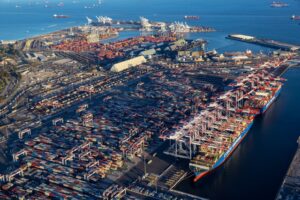Study: Pollutant emissions in ports more than doubled during pandemic
The pollutant emissions from the shipping sector increased significantly in major international seaports during the COVID-19 pandemic, researchers from Nanyang Technological University, Singapore (NTU Singapore) have found.

As informed, the NTU research team’s computations of pollutant emissions were from July 2020 to July 2021, which was at the height of the pandemic. The findings were compared to the whole of 2019 which is taken as the baseline year with business-as-usual emissions.
The pollutants studied in the research were carbon dioxide, sulphur oxide, nitrogen oxide, particulate matter, carbon monoxide and methane.
Specifically, the NTU team calculated the fuel consumption and pollutant emissions of the ships using actual ship movement data sourced through AXSMarine, a global provider of dry, tanker and liner chartering. It provided information of the ships, including their sailing speed, time duration, coordinates, navigational status, as well as ship-specific information such as the name, type of carrier, and deadweight tonnage (DWT), which is a measure of how much weight a ship can carry.
Additional information was also obtained from the various port administration authorities where the study was done, as well as from the intelligence arm of international UK shipping services provider Clarksons, which provided ship specification information, such as the ships’ designed maximum speed, engine type, and rated engine power.
The team found that emission have more than doubled (123 per cent), during the pandemic period, while they increased twofold in Los Angeles (100 per cent), almost two-thirds (65 per cent) in Long Beach, California, and over a quarter (27 per cent) in Hamburg, Germany.
In addition, the NTU study showed that ship emissions in all four ports increased by an average of 79 per cent because of the prolonged turnaround time in port with extended ‘hotelling’ time at berth and anchorage areas as longer operational times were needed due to pandemic-related delays.
What is more, the containerships and dry bulk carriers marked the sharpest increase of all total emissions, seeing an average increment of 94 per cent and 142 per cent respectively, compared to before the COVID-19 pandemic.
“Our study presents a review of the ship emission outlook amid the pandemic uncertainty. Lockdown measures and other COVID-19 restrictions on human activity have upended the landscape for the shipping sector and significantly affected the operating patterns of maritime and trade, leading to the computed outcome revealing significant increase in pollutant emissions in the seaports in our study,” Professor Adrian Law Wing Keung from NTU’s School of Civil and Environmental Engineering, who led the study, said.
“Although they typically spend the least time in ports, dry bulk carriers, which are merchant ships designed to transport unpackaged bulk cargo, such as grains, coal, ore, and cement, experienced the biggest increase in pollutant emissions. This is due to a combination of COVID-19 precautions at ports and the increased demand for raw materials due to the resumption of industrial activity in the second half of 2020, which resulted in a spike in dry bulk carriers in ports,” Liu Jiahui, a PhD student from NTU’s School of Civil and Environmental Engineering, who was the first author of the study, commented.
Future COVID-19 scenarios for ship emissions
The NTU study has also focused on he ship emission simulations for two future COVID-19 scenarios from August 2021 to August 2022. Based on the recent findings, the team created two possible scenarios:
- Scenario 1 assumes that the port congestion due to COVID-19 is resolved and the port turnaround time returns to levels in 2019 before the pandemic
- Scenario 2 assumes that the port congestion due to COVID-19 continues next year in the same manner as the current situation in the four major ports.
In Scenario 1, the researchers predict that there will be a high likelihood (over 50 per cent probability) that ship emissions would decrease by at least 34 per cent compared to the July 2020–July 2021 pandemic period.
However, in Scenario 2, substantial ship pollutant emissions are expected to continue, with Singapore most likely (90 per cent probability) to have a further emission increase of about 6 per cent higher, and with a cumulative increase of 137 per cent from 2019 levels. The ports of Hamburg, Long Beach and Los Angeles would also be likely to continue the increase with marginally higher emissions, according to the NTU team.
This possible outcome was attributed to the effects of ship traffic growth, and the prolonged port turnaround time at berth and anchorage areas, leading to longer periods of adverse impacts.
“Our scenarios have drawn attention to a shift in the overall emission pattern during the pandemic period compared to pre-pandemic levels. We hope that the results can assist in the development for countermeasures and compensatory plans to mitigate the impacts in a post-COVID future around the world,” Professor Law concluded.
Meanwhile, in an effort to upgrade ports, strengthen supply chains, reduce costs and cut emissions from the ports, the US government has recently passed legislation as part of which billions of dollars will be invested in US ports, waterways and freight networks.
Related Article
-
Embracing sustainability, US gov’t makes ‘biggest ever’ investment in ports
Authorities & Government
The role of ports around the world in tackling climate change and reducing the impact of carbon emissions was also recognized in a report published by classification society DNV GL last year. According to the report, ports can play a pivotal role in the world’s decarbonization challenge by becoming renewable energy hubs.
Related Article
-
Report: Ports can be front runners of energy transition
Ports & Logistics








